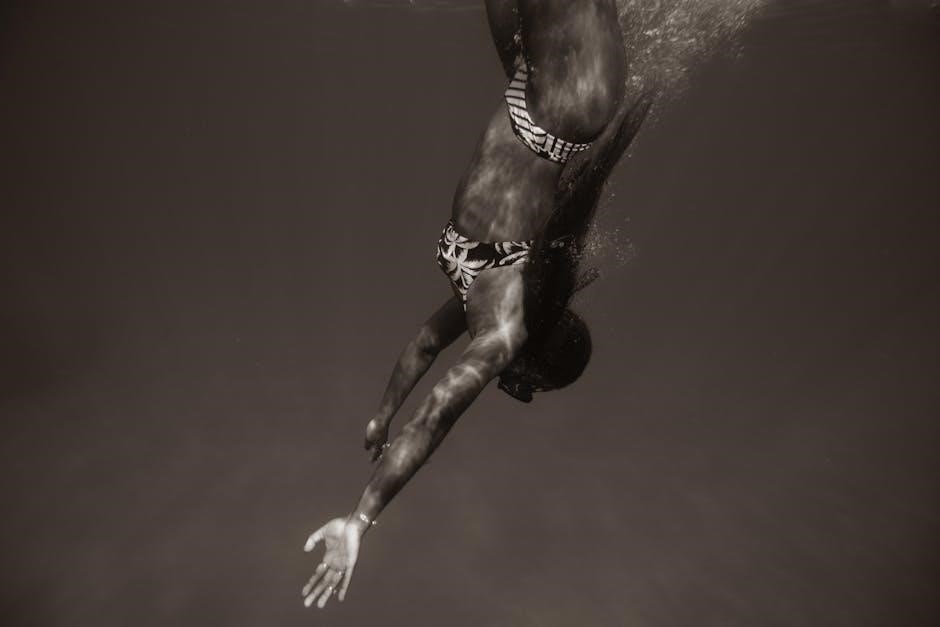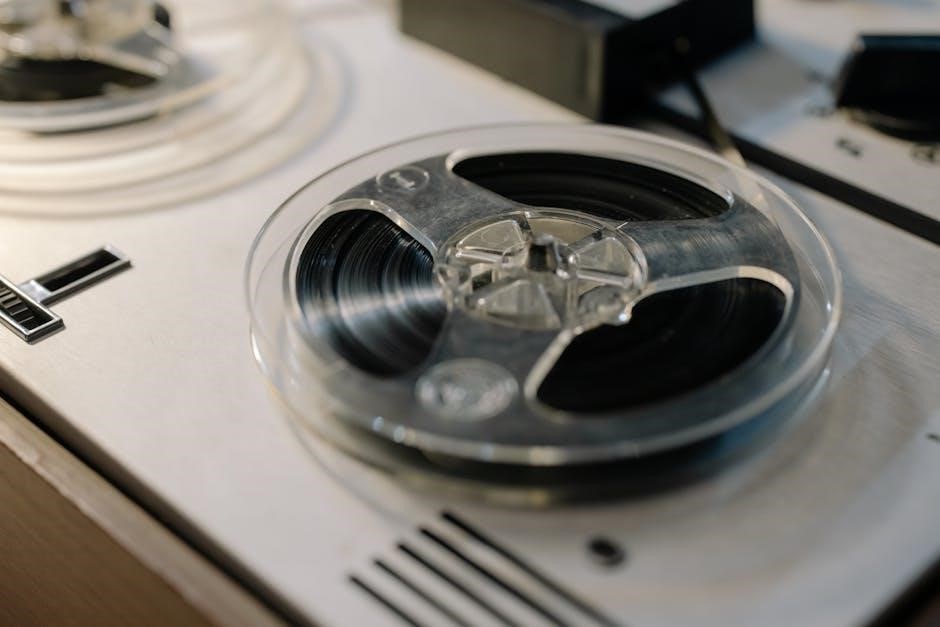Welcome to the Canon EOS 1D Mark II manual, your comprehensive guide to mastering this high-performance DSLR camera. This Spanish-language manual provides detailed instructions for optimal use.
Discover essential camera operations, advanced features, and troubleshooting tips to enhance your photography experience. Download the free PDF manual for easy access to all the information you need.
Overview of the Canon EOS 1D Mark II
The Canon EOS 1D Mark II is a high-performance digital SLR camera designed for professional photographers. It features an 8.20-megapixel CMOS sensor, ensuring high-quality images with precise detail. The camera is compatible with all Canon EF lenses, offering versatility for various shooting scenarios. Its robust construction and weather sealing make it durable for challenging environments. With advanced autofocus and metering systems, the EOS 1D Mark II delivers exceptional speed and accuracy, making it a reliable choice for capturing fleeting moments in photography.
Importance of the User Manual
The user manual is essential for understanding the Canon EOS 1D Mark II’s features, settings, and operations. It provides detailed guidance on shooting modes, autofocus systems, and image quality adjustments. The manual also covers customization options, troubleshooting, and maintenance tips to ensure optimal performance. By referring to the manual, users can unlock the camera’s full potential, resolve common issues, and maintain its durability. Regular updates and firmware instructions are also included, ensuring the camera remains up-to-date and functioning at its best.
Structure and Content of the Manual
The Canon EOS 1D Mark II manual is divided into clear sections for easy navigation. It begins with an equipment checklist and handling precautions, followed by nomenclature and symbols used. The manual details shooting modes, autofocus, and metering systems, as well as image quality settings. Customization options, maintenance, and troubleshooting are also covered. Available in Spanish as a 196-page PDF, it ensures comprehensive understanding of the camera’s features and optimal usage, making it an indispensable resource for photographers of all levels.

Key Features of the Canon EOS 1D Mark II
The Canon EOS 1D Mark II boasts an 8.20-megapixel CMOS sensor, high-speed autofocus, and compatibility with Canon EF lenses. Its durable construction and weather sealing ensure reliability in challenging conditions, making it a robust tool for professional photography.
8.20-Megapixel CMOS Sensor
The Canon EOS 1D Mark II features an 8.20-megapixel CMOS sensor, delivering high sensitivity and outstanding image quality. This sensor captures fine details and offers excellent dynamic range, ensuring vivid colors and sharpness. Its high resolution supports large prints and cropping without compromising quality. Designed for professional use, the sensor works seamlessly with Canon EF lenses, providing compatibility and versatility for diverse photography needs. This advanced imaging technology ensures exceptional performance in various lighting conditions, making it ideal for capturing stunning images with precision and clarity.
Compatibility with Canon EF Lenses
The Canon EOS 1D Mark II is fully compatible with Canon EF lenses, excluding EF-S lenses, ensuring versatility and wide-ranging creative options. This compatibility allows photographers to leverage the extensive range of EF lenses, from wide-angle to telephoto, for diverse shooting scenarios. The camera maintains exceptional image quality and reliable performance across all compatible lenses, making it a robust tool for professional photographers seeking flexibility and precision in their work. This feature-rich compatibility enhances the camera’s adaptability in various environments and applications.
High-Speed Autofocus System
The Canon EOS 1D Mark II features a high-speed autofocus system, designed for rapid and precise focusing in various shooting conditions. This advanced system ensures sharp images even in dynamic situations, making it ideal for sports, wildlife, and action photography. With its robust AF algorithm and high-speed motor, the camera delivers quick and accurate focus acquisition, allowing photographers to capture fleeting moments effortlessly. This feature enhances overall performance and reliability, making it a trusted choice for professionals and enthusiasts alike.
Durable Construction and Weather Sealing
The Canon EOS 1D Mark II boasts a rugged magnesium alloy body, ensuring exceptional durability and resistance to heavy use. Its weather-sealed design protects against moisture and dust, making it reliable in harsh outdoor conditions. This robust construction allows photographers to work confidently in challenging environments without compromising camera performance. The weather sealing is particularly beneficial for wildlife, sports, and outdoor photography, where exposure to elements is unavoidable. This feature enhances the camera’s longevity and ensures professional-grade reliability in demanding situations.

Getting Started with the Canon EOS 1D Mark II
Begin by unpacking and inspecting the camera, ensuring all accessories are included. Familiarize yourself with the camera’s components and essential controls for smooth operation.
Equipment Checklist
Ensure you have all necessary items to start using your Canon EOS 1D Mark II. This includes the camera body, battery, charger, memory cards, EF lenses, and external accessories like Speedlite flashes. Additionally, the Spanish-language manual provides detailed setup guidance. Always verify the completeness of the kit to avoid missing essential components for optimal performance. The manual also covers troubleshooting and maintenance tips to keep your camera in excellent condition. Proper equipment preparation ensures a seamless photography experience.
Handling Precautions
To maintain optimal performance and longevity of your Canon EOS 1D Mark II, follow these handling precautions. Avoid exposing the camera to excessive moisture or extreme temperatures. Clean the sensor regularly to prevent dust accumulation. Use only genuine Canon accessories to ensure compatibility and safety. Handle the camera with care to prevent physical damage. Store the device in a protective case when not in use. Additionally, refer to the Spanish-language manual for detailed maintenance and care guidelines to preserve your camera’s functionality and image quality. Proper handling ensures consistent performance and durability over time.
Nomenclature of Camera Parts
Familiarizing yourself with the Canon EOS 1D Mark II camera parts is essential for effective operation. Key components include the mode dial for selecting shooting modes, the shutter button for capturing images, the aperture control for adjusting lens opening, and the LCD screen for previewing shots. Understanding each part’s function enhances your ability to utilize the camera’s features fully.
Symbols Used in the Manual
The Canon EOS 1D Mark II manual employs specific symbols to guide users through camera operations. These symbols represent functions like autofocus modes, metering options, and ISO settings. They are standardized to ensure clarity, helping users quickly identify and adjust settings. The manual provides explanations for each symbol, ensuring easy navigation and optimal use of the camera’s advanced features. Familiarizing yourself with these symbols enhances your ability to utilize the camera’s full potential effectively.
Basic Camera Operations
Learn essential operations like charging the battery, inserting memory cards, and setting the date/time. These steps ensure smooth functionality and prepare you for capturing stunning images.
Charging the Battery
To ensure optimal performance, charge the battery using the provided Canon Battery Charger LC-E6. Insert the BP-511A battery into the charger, aligning the terminals correctly. Plug the charger into a power outlet and allow it to charge until the indicator light turns green, signaling a full charge. Avoid using counterfeit chargers to prevent damage. Store the battery in a cool, dry place when not in use. Always follow the manufacturer’s guidelines for charging to maintain battery health and longevity.
- Use the Canon Battery Charger LC-E6 for safety and compatibility.
- Avoid counterfeit chargers to prevent damage.
- Store the battery in a cool, dry place.
Inserting and Formatting Memory Cards
Insert a compatible CF (CompactFlash) card into the camera’s card slot, located on the right side. Ensure the card is properly aligned and fully inserted until it clicks. Format the card using the camera’s menu to optimize performance. Use a card reader to transfer images to your computer. Always format cards in the camera to maintain compatibility and prevent data loss. For best results, use high-speed CF cards recommended by Canon.
- Use CF Type I/II cards, including Microdrive.
- Format cards in the camera for optimal performance.
- Transfer images using a card reader.
Setting the Date and Time
Go to the camera menu by pressing the MENU button. Navigate to the Setup menu (wrench icon). Select Date/Time and press SET. Use the Quick Control Dial to adjust the date and time. Press SET again to confirm. Ensure the correct date and time are set for proper file naming and timestamping of images. The camera uses a built-in clock, which should be updated regularly to maintain accuracy.

Shooting Modes
The Canon EOS 1D Mark II offers versatile shooting modes, including Manual (M), Aperture Priority (Av), Shutter Priority (Tv), Program AE (P), and Bulb (B), catering to various photography needs.
Manual Mode (M)
Manual Mode (M) on the Canon EOS 1D Mark II offers full control over aperture and shutter speed, allowing photographers to customize settings for precise creative control. This mode is ideal for experienced users who prefer to adjust exposures manually. The camera provides clear feedback on settings, enabling precise adjustments to achieve the desired visual effect in various lighting conditions. Manual Mode is particularly useful for capturing high-contrast scenes and fine-tuning image aesthetics.
Aperture Priority Mode (Av)
In Aperture Priority Mode (Av), you set the aperture, and the camera automatically adjusts the shutter speed to ensure proper exposure. This mode is ideal for controlling depth of field, allowing you to isolate subjects or ensure sharpness across the frame. Use the aperture ring or the Canon EOS 1D Mark II’s controls to select your desired f-stop, while the camera handles the rest. This mode is perfect for portraits, landscapes, and creative photography where depth of field is critical.
Shutter Priority Mode (Tv)
In Shutter Priority Mode (Tv), you manually set the shutter speed, and the camera automatically adjusts the aperture to achieve the correct exposure. This mode is perfect for capturing motion, such as freezing fast-moving subjects or creating artistic motion blur. Use the Canon EOS 1D Mark II’s controls to select your desired shutter speed, ranging from 1/8000th of a second to 30 seconds. This mode offers creative control over motion and is ideal for sports, wildlife, and dynamic photography.
Program AE Mode (P)
Program AE Mode (P) allows the camera to automatically set both the aperture and shutter speed for optimal exposure. This mode is ideal for beginners or quick shooting situations where manual adjustments are unnecessary. The camera selects settings based on the scene, ensuring balanced exposure. While it offers less creative control, it provides reliable results in various lighting conditions. Advanced users may prefer manual modes for more customization, but Program AE is a convenient option for everyday photography.
Bulb Mode (B)
Bulb Mode (B) allows for extended exposure times, controlled manually by the photographer. The shutter remains open as long as the shutter button is pressed, enabling creative effects like light trails or star movements. This mode is ideal for low-light conditions and artistic photography. Use a remote shutter release or the camera’s timer to minimize camera shake. The exposure time is limited only by the photographer’s input, offering maximum control for unique and experimental results.

Autofocus and Metering Systems
The Canon EOS 1D Mark II features an advanced autofocus system for sharp images and precise control. Metering modes include evaluative, center-weighted, and spot options, ensuring adaptability to various lighting conditions for optimal results.
Autofocus Modes
The Canon EOS 1D Mark II offers multiple autofocus modes to suit various shooting scenarios. One-Shot AF is ideal for stationary subjects, focusing once and locking the distance. AI Servo AF is designed for moving subjects, continuously adjusting focus to track motion. Additionally, Manual Focus allows precise control over focusing using the lens ring. The camera also features customizable AF points and AF area selection modes, enhancing flexibility and accuracy in different photographic situations. These modes ensure sharp results, whether capturing stills or dynamic action.
Metering Modes
The Canon EOS 1D Mark II features advanced metering modes to ensure accurate exposure. The Evaluative Metering mode analyzes the entire scene, weighing brightness and color for optimal results. Center-Weighted Average Metering prioritizes the central area, ideal for portraits. Spot Metering measures light from a small, selectable area, perfect for high-contrast scenes. These modes, combined with the camera’s 16-zone metering system, provide precise control over exposure, helping you capture images with balanced lighting and detail.
WB (White Balance) Settings
The Canon EOS 1D Mark II offers multiple White Balance (WB) settings to accurately capture colors under various lighting conditions. Options include Auto, Daylight, Shade, Tungsten, Fluorescent, and Custom. The Custom WB allows you to set a specific white balance by capturing a reference image. These settings ensure precise color reproduction, enhancing image quality and reducing post-processing time. Adjusting WB helps achieve natural-looking images, whether in sunlight, indoor lighting, or mixed conditions, making it a powerful tool for professional photographers.

Image Quality Settings
Adjust image resolution, compression, and color space to optimize quality. Choose from various JPEG settings or RAW format for maximum detail and flexibility in post-processing.
Image Resolution and Compression
The Canon EOS 1D Mark II offers multiple resolution settings, ranging from 3504 x 2336 pixels to 1728 x 1152 pixels, ensuring versatility for different shooting needs. Compression options include Fine, Normal, and Basic JPEG settings, allowing users to balance file size and image quality. The camera also supports RAW format, capturing uncompressed data for maximum post-processing flexibility. Properly managing resolution and compression ensures optimal storage and maintains high image quality, catering to both professional and amateur photographers.
Color Space Options
The Canon EOS 1D Mark II supports two color space options: sRGB and Adobe RGB. The sRGB profile is ideal for general use, ensuring consistent color representation across devices and web platforms. Adobe RGB offers a wider color gamut, making it suitable for professional photography and printing. These settings allow photographers to tailor their workflow to specific needs, ensuring accurate color reproduction in various environments.
Choosing the right color space depends on the intended use of the images, enabling better control over the final output and maintaining color fidelity.
Picture Style Settings
The Canon EOS 1D Mark II offers customizable Picture Style settings, allowing photographers to fine-tune image characteristics such as contrast, saturation, and sharpness. These settings include options like Standard, Portrait, Landscape, Neutral, and Monochrome, catering to various shooting scenarios and creative preferences.
Each style can be adjusted to suit individual needs, providing flexibility in achieving desired image aesthetics. These settings are applied during image processing, ensuring consistent results without altering RAW file data, making them ideal for both professional and enthusiast photographers.

Customization Options
Explore the Canon EOS 1D Mark II’s Custom Functions and personalize settings to match your photography style. Tailor camera behavior for enhanced control and efficiency in various shooting conditions.
Custom Functions
The Canon EOS 1D Mark II offers a range of Custom Functions to tailor camera settings to your preferences. These functions allow you to customize autofocus behavior, metering modes, and button assignments. You can also customize file naming, image quality settings, and more. This feature enhances shooting efficiency and personalizes the camera to suit your workflow. Detailed instructions for configuring Custom Functions are provided in the manual, ensuring you can optimize the camera for your specific needs. Explore these options to unlock the full potential of your photography.
Personalizing Camera Settings
The Canon EOS 1D Mark II allows you to personalize camera settings to suit your shooting style. Customize button assignments, menu options, and LCD displays for easy access to frequently used functions. You can also save personalized settings to ensure quick adjustments during shoots. This feature enhances workflow efficiency and ensures the camera adapts to your creative needs. The manual provides detailed guidance on how to configure these settings effectively, helping you maximize the camera’s potential for professional results. Explore and tailor the settings to match your photography preferences;
Using Flash and External Accessories
The Canon EOS 1D Mark II supports Speedlite flashes and external accessories, enhancing your photography experience. Use Speedlite EX series for advanced lighting control and connect external microphones or remotes for added functionality. The manual provides detailed instructions for setup and operation, ensuring seamless integration of these accessories to expand your creative possibilities. Explore these tools to elevate your shooting capabilities.
Using Speedlite Flashes
The Canon EOS 1D Mark II is fully compatible with Speedlite EX flashes, offering advanced lighting control. Use E-TTL II metering for precise flash exposure. The camera supports bounce flash and wireless flash operation for creative lighting setups. For manual flash exposure, refer to Page 113 of the manual. This feature enhances your photography by allowing greater control over lighting conditions. The manual provides detailed guidance on setting up and troubleshooting flash operations, ensuring optimal results in various shooting scenarios.
Connecting External Microphones
The Canon EOS 1D Mark II allows you to connect external microphones for high-quality audio recording. Simply plug the microphone into the camera’s external microphone input. Ensure the microphone is compatible with the camera’s specifications for optimal performance. The manual provides detailed instructions for connecting and configuring external microphones. This feature is particularly useful for videography and capturing clear audio in various shooting environments. Refer to the manual for troubleshooting common issues related to external microphone connections and settings.
Remote Shutter Release
The Canon EOS 1D Mark II supports remote shutter release, enabling vibration-free shooting. This feature is ideal for long exposures, macro photography, or minimizing camera shake. Use a compatible remote shutter release accessory to activate the camera’s shutter without physical contact. The manual provides step-by-step instructions for setting up and using this feature effectively. Troubleshooting tips are also included to address common issues related to remote shutter release functionality, ensuring smooth operation during your photography sessions.

Maintenance and Troubleshooting
Regularly clean the camera and sensor to maintain performance. Troubleshoot common issues like error messages or connectivity problems. Refer to the manual for detailed solutions and care tips.
Cleaning the Camera and Sensor
Regular cleaning is essential to maintain the Canon EOS 1D Mark II’s performance. Use a soft, dry cloth to wipe the camera body and lens surfaces. Avoid liquids, as they may damage electrical components. For the sensor, use a manually operated cleaning brush or blower. Refer to the manual for detailed instructions on mirror and sensor cleaning. If stubborn debris persists, consider professional cleaning services to prevent damage. Proper maintenance ensures optimal image quality and extends the camera’s lifespan.
Troubleshooting Common Issues
If you encounter error messages, check the manual for solutions or contact Canon support. For memory card errors, format the card in-camera or replace it if damaged. Battery performance issues? Ensure proper charging and avoid extreme temperatures. If the camera fails to power on, test with a different battery or charger. For unresolved problems, perform a factory reset or update firmware. Regular maintenance and updates help prevent common issues, ensuring optimal performance and image quality.

Software and Firmware Updates
Download software and firmware updates for your Canon EOS 1D Mark II from the official Canon website. Use CameraWindow or EOS Utility for easy installation. Visit the Canon support page for the latest updates and installation instructions to ensure optimal camera performance.
Downloading and Installing Updates
To ensure your Canon EOS 1D Mark II performs optimally, visit the official Canon website. Navigate to the support page, select your camera model, and download the latest software or firmware updates. Use EOS Utility or CameraWindow for a seamless installation process. Follow the on-screen instructions carefully to complete the update. Always connect your camera to the computer during the installation to avoid interruptions. Regular updates enhance performance, add features, and improve security. Ensure your camera is fully updated for the best experience.
Updating Firmware
The Canon EOS 1D Mark II firmware can be updated using the EOS Utility software. Download the latest firmware from the official Canon support website. Connect your camera to the computer via USB and launch the software. Select the firmware file and follow the on-screen instructions to complete the update. Ensure the camera remains connected throughout the process to prevent any issues.
Avoid interrupting the update, as this could damage the camera. Once completed, restart the camera to apply the new firmware. Regular updates improve functionality and performance, ensuring optimal use of your device.

Frequently Asked Questions
Find answers to common questions about the Canon EOS 1D Mark II, covering compatibility, troubleshooting, and firmware updates. Visit the official Canon support page for detailed solutions.
General Usage Questions
Canon EOS 1D Mark II users often inquire about basic operations, such as charging the battery, inserting memory cards, and setting the date and time. The manual provides clear instructions for these tasks to ensure smooth camera operation. Additionally, questions about shooting modes, like Manual (M) and Aperture Priority (Av), are common, with users seeking guidance on optimizing image quality. The manual addresses these topics in detail, offering step-by-step solutions for everyday use and advanced photography techniques;
Tech Support and Resources
For assistance with the Canon EOS 1D Mark II, visit the official Canon website for software, firmware updates, and detailed manuals. The Picture Style Editor manual is available for download, along with troubleshooting guides. Users can access FAQs, technical support resources, and customer service for unresolved issues. The manual also provides links to additional resources, ensuring comprehensive support for optimizing camera performance and resolving technical queries efficiently.
Mastery of the Canon EOS 1D Mark II begins with this comprehensive guide. Explore its key features, customization options, and troubleshooting solutions. Refer to the manual and online resources for continued support and optimal performance.
Final Tips for Maximizing Camera Performance
To maximize your Canon EOS 1D Mark II performance, regularly update firmware and software via Canon’s official website. Clean the sensor and camera body to maintain image quality. Use high-quality memory cards and ensure proper battery maintenance. Explore all shooting modes and customize settings to suit your needs. Refer to the Spanish-language manual for detailed guidance on advanced features and troubleshooting common issues. Utilize external accessories like Speedlites and remote shutters for professional results. Lastly, always store the camera in a protective case to preserve its durability and functionality over time.
